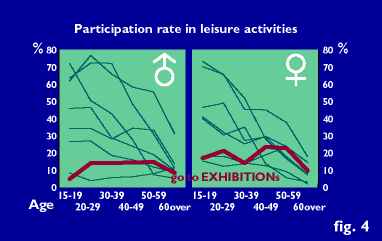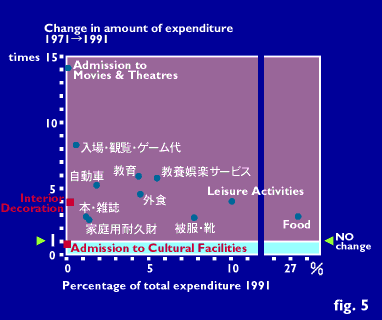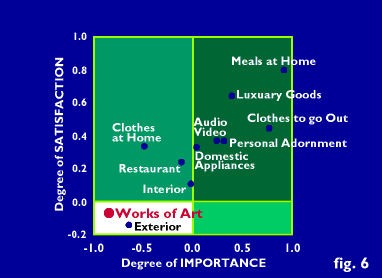
Art is unnoticed amid today's surfeit of information.
Not many people come in contact with art
amid the "sea of information".

Interest and investment in art have not changed,
but declined, relative to those in other fields.

|
|
|
|
|
|
 Figure 5 shows the scale and changes in expenditure on each item
in a family. Figure 5 shows the scale and changes in expenditure on each item
in a family.  The proportion of expenditure on interior decoration (including
artworks) and admission to cultural facilities (including museums)
to the total is very small. Expenditure on interior decoration
has increased four times in 20 years, but this rate of increase
is not large compared with that of the total expenditure on leisure
activities. Expenditure on admission to cultural facilities has
decreased in 20 years. The proportion of expenditure on interior decoration (including
artworks) and admission to cultural facilities (including museums)
to the total is very small. Expenditure on interior decoration
has increased four times in 20 years, but this rate of increase
is not large compared with that of the total expenditure on leisure
activities. Expenditure on admission to cultural facilities has
decreased in 20 years.  The expenditure on food is the largest, and the rate of increase
of expenditure on admission to movies and theatres is the highest. The expenditure on food is the largest, and the rate of increase
of expenditure on admission to movies and theatres is the highest. |
|
Among the goods related to food, clothing and
shelter,works of art are considered the least
satisfactory and important.

|
|
|
|
|
|
 Figure 6 shows how important and satisfactory different items
related ro food, clothing and shelter are for the Japanese. Figure 6 shows how important and satisfactory different items
related ro food, clothing and shelter are for the Japanese.  Works of art and exterior architecture are regarded as far less
important and satisfactory than the other items. Works of art and exterior architecture are regarded as far less
important and satisfactory than the other items.  Meals at home and luxury goods are regarded as both highly important
and satisfactory. The items related to clothing are regarded as
very important. Meals at home and luxury goods are regarded as both highly important
and satisfactory. The items related to clothing are regarded as
very important. |
|
Art is unnoticed amid today's surfeit of information.



Back | Top | NEXT
![]()
![]()


